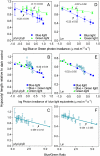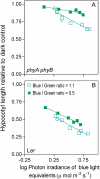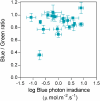Cryptochrome as a sensor of the blue/green ratio of natural radiation in Arabidopsis
- PMID: 20668058
- PMCID: PMC2938137
- DOI: 10.1104/pp.110.160820
Cryptochrome as a sensor of the blue/green ratio of natural radiation in Arabidopsis
Abstract
Green light added to blue light has been proposed to shift cryptochromes from their semireduced active form to the reduced, inactive state. Whether the increased proportion of green light observed under leaf canopies compared to open places reduces cryptochrome-mediated effects remained to be elucidated. Here we report that the length of the hypocotyl of Arabidopsis (Arabidopsis thaliana) seedlings grown under controlled conditions decreased linearly with increasing blue/green ratios of the light within the range of ratios found in natural environments. This effect was stronger under higher irradiances. We developed a model, parameterized on the basis of field experiments including photoreceptor mutants, where hypocotyl growth of seedlings exposed to different natural radiation environments was related to the action and interaction of phytochromes and cryptochromes. Adding the blue/green ratio of the light in the term involving cryptochrome activity improved the goodness of fit of the model, thus supporting a role of the blue/green ratio under natural radiation. The blue/green ratio decreased sharply with increasing shade by green grass leaves to one-half of the values observed in open places. The impact of blue/green ratio on cryptochrome-mediated inhibition of hypocotyl growth was at least as large as that of irradiance. We conclude that cryptochrome is a sensor of blue irradiance and blue/green ratio.
Figures







References
-
- Ahmad M, Cashmore AR. (1993) HY4 gene of Arabidopsis thaliana encodes a protein with characteristics of a blue-light photoreceptor. Nature 366: 162–166 - PubMed
-
- Banerjee R, Schleicher E, Meier S, Viana RM, Pokorny R, Ahmad M, Bittl R, Batschauer A. (2007) The signaling state of Arabidopsis cryptochrome 2 contains flavin semiquinone. J Biol Chem 282: 14916–14922 - PubMed
-
- Bouly JP, Schleicher E, Dionisio-Sese M, Vandenbussche F, Van Der Straeten D, Bakrim N, Meier S, Batschauer A, Galland P, Bittl R, et al. (2007) Cryptochrome blue light photoreceptors are activated through interconversion of flavin redox states. J Biol Chem 282: 9383–9391 - PubMed
-
- Briggs W, Christie J. (2002) Phototropins 1 and 2: versatile plant blue-light receptors. Trends Plant Sci 7: 204–210 - PubMed
Publication types
MeSH terms
Substances
LinkOut - more resources
Full Text Sources
Other Literature Sources
Molecular Biology Databases

